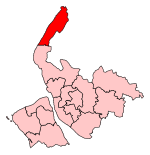British Lawnmower Museum
Buildings and structures in SouthportGardening in EnglandLawn mowersMuseums in MerseysideTechnology museums in the United Kingdom ... and 2 more
United Kingdom museum stubsUse British English from February 2023

The British Lawnmower Museum is a museum dedicated to the history of the lawnmowers in Southport, Merseyside, northern England.The museum has over 300 restored exhibits of garden machinery from over the last 200 years, as well as a collection of lawnmowers previously owned by famous people including Prince Charles and Princess Diana, guitarist Brian May, performer and presenter Paul O'Grady, and Coronation Street actress Jean Alexander, who lived in Southport for many years. The museum has workshops that restore lawnmowers for the collection and others around the world. The collection includes patents and blueprints dating from 1799.
Excerpt from the Wikipedia article British Lawnmower Museum (License: CC BY-SA 3.0, Authors, Images).British Lawnmower Museum
Shakespeare Street,
Geographical coordinates (GPS) Address Nearby Places Show on map
Geographical coordinates (GPS)
| Latitude | Longitude |
|---|---|
| N 53.639381 ° | E -3.004895 ° |
Address
SHAKESPEARE ST
Shakespeare Street
PR8 5AJ
England, United Kingdom
Open on Google Maps








